The Hoth asteroid field, also known as the Anoat Asteroid Belt and Hoth Asteroid Belt, was an extensive, wildly erratic asteroid belt in the isolated Hoth and Anoat systems in the Outer Rim Territories. Forged as the resulting effect of a collision between two rocky planets eons prior to the Galactic Civil War, the belt was rich in untapped mineral resources such as metal ore, a magnet for mining prospectors hoping to make a fortune. However, it was plagued by silicon-based creatures like mynocks and the mighty exogorths, or space slugs, which, coupled with ceaseless asteroid collisions, imperiled any passing spacecraft. The chaotic nature of the field further sent a constant bombardment of meteorites to the surface of Hoth, the system's sixth planet.
The field was thus a favored sanctuary for those hoping to elude legal authority. Rampant criminal activity prompted law enforcement, including Jedi—such as Qui-Gon Jinn, who once led a patrol for smugglers, and Obi-Wan Kenobi and Anakin Skywalker, who apprehended a rogue Jedi on the Poison Moon—to investigate the field, though often unsuccessfully. Indeed, pirates, most notoriously those of Clabburn the Elder in the time of the Galactic Republic, proved an enduring presence in the Hoth asteroid field, which was populated by numerous bases from which raids were launched along the Anoat trade corridor.
The elusive nature of the belt made the planet Hoth an ideal location for the Rebellion's headquarters. While the Rebels on Hoth monitored surrounding meteor activity for signs of the Empire, their stay was short-lived. Spearheaded by Darth Vader, the Empire forced the Rebels into retreat at the Battle of Hoth in 3 ABY, scattering their forces. Consequently, Han Solo braved the perils of the asteroid field in the Millennium Falcon as part of a desperate ploy to escape the Imperial Starfleet.
Believing the aspiring Jedi Rebel Luke Skywalker to be aboard the Falcon, Vader deployed the full force of his personal fleet and employed bounty hunters to track down the ship. For a while, it hid inside the asteroid field's largest planetoid, where Solo and Princess Leia Organa fell in love. After a close brush with death in the belly of the gargantuan exogorth that made that asteroid its home and further Imperial pursuit, the crew of the Falcon successfully navigated the field's expanse against all odds.
Later, in 12 ABY, Durga the Hutt secretly constructed within the belt the Darksaber superweapon, designed to dominate the galaxy. While the Jedi Luke Skywalker and Callista Ming, having been rescued by Han Solo and Leia Organa Solo from the belt after their damaged ship was stranded there, failed to detect the Darksaber, it was soon discovered by New Republic General Crix Madine. A Republic attack force under the command of Wedge Antilles pursued the weapon through the field, ultimately destroying the Darksaber as it was crushed between two planetoids.

A cacophony of planetesimals surrounded the Hoth system.
The Hoth asteroid field, also named the Anoat Asteroid Belt and Hoth Asteroid Belt, was an especially wide swath of countless free-ranging planetesimals confined to erratic orbits along the isolated Hoth system's ecliptic. Occupying that system's outermost orbit but with stray bodies scattered throughout, its reach extended to the nearby Anoat system, where it occupied the sixth orbit around the star of the same name, between the planets Deyer and Pujool. In close proximity to the Anoat trade corridor that connected the Anoat and Bespin systems, which were joined up with the Hoth system by the Ison Corridor space lane, the asteroid field was situated in the Anoat sector of the Outer Rim Territories' Greater Javin region and was the result of a collision billions of years prior to the Galactic Civil War.
The collision was between two large and rocky planets of the Hoth system. The worlds were fractured into scattered chunks of debris that were strewn throughout the system and eventually were pulled into erratic orbits around Hoth, the system's star. The largest asteroids, continually tugging at each other, destroyed any possibility of maintaining a rigid orbit. The Hoth system's planets were the frequent recipients of meteorite collisions from asteroids that had broken away from the field as a result. In particular, a steady stream of meteorites constantly bombarded the ice planet Hoth, occupying the system's sixth orbit as its outermost and sole habitable world. Combined with the planet's three moons, large meteor impacts enacted tidal forces that cracked Hoth's ice shelves, allowing geysers to erupt before the frigid temperatures quickly sealed the breaches, forming darker and smoother ice. Meteor impacts also blasted smooth craters in the ice that made ideal ice-skating rinks.
Scientists and surveyors also speculated that the asteroid field may have formed after the crumbling of one of the planet Hoth's own moons, or even that the two planets' collision caused the moons to crumble, supplementing the rock storm. The belt was also thought to potentially be the remains of an unformed planet.
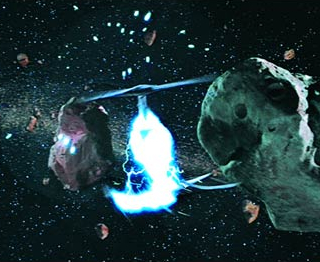
A TIE Fighter collides in the maelstrom.
Throughout the belt's existence, rocky chunks continued to constantly collide with one another, grinding each other down to smaller asteroids. During the belt's early years, the collisions were catastrophic, creating vast craters in the many large asteroids. The collisions became less frequent and less powerful by comparison as the field matured, and the asteroids entered relatively stable orbits. As the asteroids collided and increased in number, the composition of the belt's thickest region grew in range from microscopic dust particles to tiny pebbles, large boulders, and, in the Anoat system, irregularly shaped planetoids that rivaled small moons in size.
The Hoth asteroid field threatened to pulverise any spacecraft that chanced its random maelstrom and constant collisions; it was a certain deathtrap for pilots hoping to successfully traverse the field. The chaotic nature of the asteroid field thus created an environment all but impossible for charting, proving a great hazard for hyperspace travel through the remote region.
Dotted with craters and narrow gorges, larger asteroids also featured fissures and spacious caves; giant exogorths dwelled within them and consumed surrounding rock as part of its diet, enlargening its burrows in the process. Some asteroids were massive enough to contain scant atmospheres—when the Humans Leia Organa and Han Solo and the Wookiee Chewbacca inadvertently explored the belly of an exogorth living inside an asteroid, they simply wore Roamer-6 breath masks.
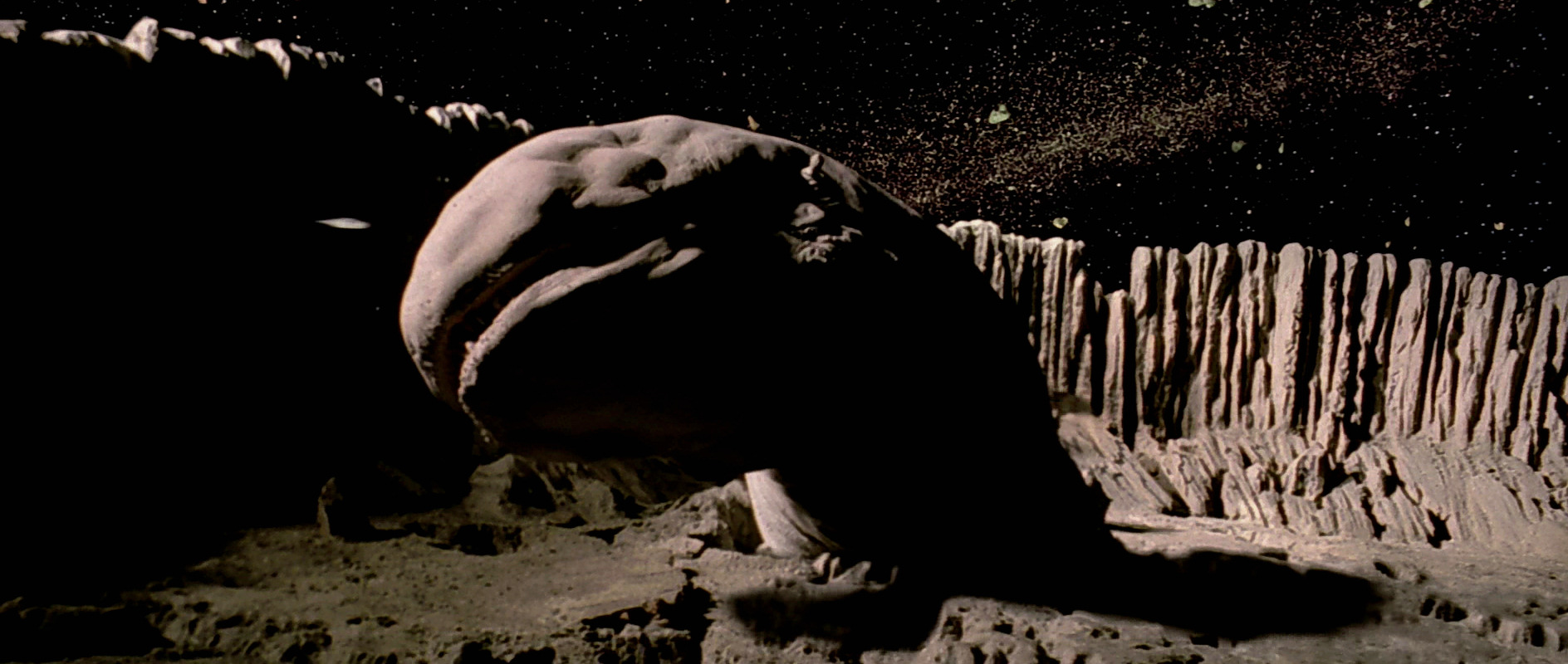
A 900-meter-long exogorth emerges from one of the field's largest asteroids.
The field's asteroids were rich in mineral composition, the lasting deposits of the two planetary cores. Indeed, the asteroids were composed of a vast array of different minerals and metal ores, including nickel and iron—one asteroid was even rumored to be comprised entirely of platinum. The high metal concentration of the asteroids had a tendency to cause sensor distortions for passing starships.
A rare growth found among many of the asteroids were crystal ferns, strange transparent, silicon-based crystals produced as an effect of some rocks' exposure to heavy radiation and cold vacuum. The crystals grew in delicate, web-like tangles extending several meters from their base on the surface of an asteroid and propagated from one asteroid to another, broken in shards that were carried to other rocks by orbital forces.
The asteroid field's very high mineral content and presence of some organic material, including frozen water, meant that some extraordinary creatures occupied the asteroid field. Many of the larger asteroids were inhabited by the wormlike exogorths, colloquially called "space slugs"—one of the largest creatures known to the universe. Those inhabiting the Hoth asteroid field were the largest recorded. Aside from silicon, exogorths also consumed organics by ingesting passing starships and other creatures, posing a severe threat to space travel and mining in the belt. Prior to the fall of the Galactic Republic, the space pirate Clabburn the Elder installed the space slugs as guardians within the hollow shaft entrances of asteroids that led to his secret hives of operation.
In low asteroidal gravity and over many centuries, these space slugs grew to enormous proportions, some reaching lengths of 900 meters. The slugs were able to survive within the thin atmospheres of the larger asteroids, subsisting for many years by breaking down the rock of the asteroid itself. Long tendrils extended from the rear portion of the creatures that reached into the asteroids to extract nutrients. Slugs in old age would petrify, transforming into caves themselves.By the early years of the Galactic Civil War, thousands of space slugs populated the asteroid field.
In turn, winged, parasitic creatures known as mynocks inhabited these giant space slugs. Silicon-based lifeforms able to survive in vacuum, mynocks typically assumed sanctuary within their hosts and leached off the soft inner membranes of the slugs' interiors and the thermal energy they radiated as heat. Large numbers of mynock packs lived in the field, attaching themselves to the outer hull of the occasional passing starship to drain the vessel's concentrated energy.

Hidden in the asteroids were valuable mineral deposits.
The asteroid belt was an opulent source of untapped wealth for the galaxy at large. The mineral deposits laying in store within the asteroids themselves promised instant reward to anyone who was able to extract them. For many years prior to the fall of the Galactic Republic, Hoth's asteroid belt was a powerful attractant to several such prospectors—independent, or otherwise—hoping to strike it rich. The belt's hazardous and erratic pitfalls were not enough to deter these entrepreneurs from accepting the gambit of potential death for wealth. Nevertheless, by 12 ABY, the field's resources still remained largely untapped despite previous efforts.
A popularly persistent legend existed of one particular asteroid that was rumored to be nothing less than a mass of nearly pure platinum. The chunk of ore became anecdotally known as Kerane's Folly because the prospector Kerane, having supposedly discovered the asteroid, extracted a sample and exited the asteroid field in order to confirm that it was indeed the precious metal he sought. When he returned to the field, he found he could not relocate his treasure. Kerane spent the rest of his life searching the Hoth asteroid field, but was never able to recover the asteroid. This story had spurred other prospectors into searching for the platinum asteroid for years without success.
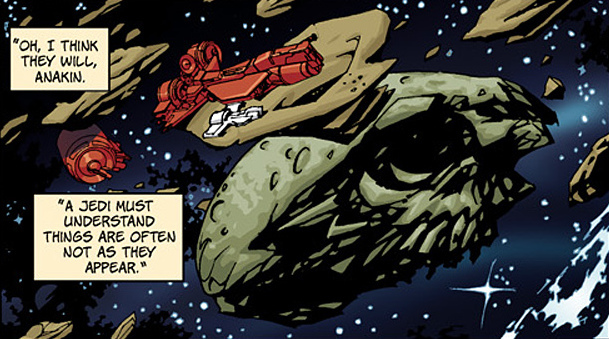
The Poison Moon asteroid
For centuries the field also proved to be a favorite hiding place for many smugglers and pirates. Rumors abounded about pirate treasure that lay hidden deep within the field. The larger asteroids with minimal atmospheres served as strongholds for many hostile criminals, where they discovered they were relatively safe from any lawful hand of judgment. Governmental organizations alike, from the Republic and the Galactic Empire, to independent planetary police forces, had lost elusive prey into the confines of the wild asteroid assortment. They each determined that, after numerous enforcement ships were lost in pursuit, once a refugee managed to reach the asteroid belt, continuing the chase was an exercise in futility.
Reports of smugglers raiding a small mining station in the asteroid field came to the attention of the Jedi Council sometime prior to the Battle of Naboo in 32 BBY. The responsibility fell to Jedi Master Qui-Gon Jinn to assemble a team of Jedi to patrol the area for suspicious smugglers.
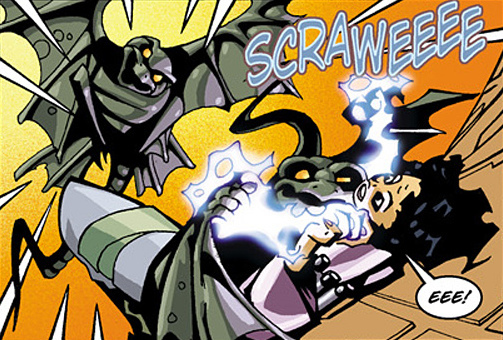
Mynocks attack the Dark Jedi Alysun Celz.
One large asteroid in particular was known among pirate groups as the Poison Moon because of its surface appearance. In 25 BBY—three years prior to the onset of the Clone Wars—the Republic Consular-class cruiser Radiant IX was sucked into the gravity well of the asteroid after a group of mynocks leeched power from the exterior of the ship. The Jedi Knight Obi-Wan Kenobi and his Padawan learner, Anakin Skywalker, arrived at the crash site responding to a distress beacon. They discovered the Radiant IX had been carrying a group of Jedi en route back to Coruscant, where they hoped to deliver the captive Dark Jedi Alysun Celz to the Jedi Council. Kenobi and Skywalker were able to rescue the lone Jedi survivor, Et Rex, and detain Celz.
Sometime prior to the fall of the Republic, the Mugaari pirate Icanis Tsur and a crew of thirty manning his ship, the 80-Vag, were killed when the craft was destroyed within the field. The ship's wreckage was pilfered by Squib teams and rogue scavengers as it floated among the asteroids. However, many of these foragers were similarly destroyed in the process, adding to the very debris they were hoping to retrieve.

The Hoth asteroid field neighbored the resorts of Bespin.
The asteroid field was also known notoriously as the haven of operations for the pirate Clabburn the Elder, an uncompassionate Mugaari, during the last decades of the Republic. Striking from the safety of the field, Clabburn and his forces would stalk the most populated hyperlanes running through the Anoat trade corridor, typically attacking wealthy tourists in luxury liners en route to the nearby resort of Cloud City on the gas giant Bespin in the Bespin system.
Bounty hunters, police forces, and vengeful family members of the besieged attempted to hunt Clabburn, but were unable to locate his base within the field. The pirate took precaution to constantly relocate from one planetoid to another, always covering his tracks and booby-trapping his previously used facilities. Clabburn acquired and installed giant exogorths at the entrances of his discarded bases to devour anyone brave enough to track him. Spacer legend later recounted Clabburn's use of space slug guardbeasts for his mobile asteroid headquarters, while other legends mentioned that those slugs grew to ginormous proportions due to the field's lack of gravity.
At some point following the Battle of Yavin, another Mugaari pirate, Clabburn the Younger, the son of the elder Clabburn, attempted to fashion his own pirating career after that of his father. He similarly created a secret base within the field, drilled deep into the nickel-iron core of one of the larger asteroids, known as Airtight Base for its impregnable security. Also like his father before him, the younger Clabburn used some of the field's exogorths, which had multiplied to thousands in number by this time, as a security measure. He planted them in caves flanking Airtight Base, training them to attack a threatening ship by way of ultrasonic signal.
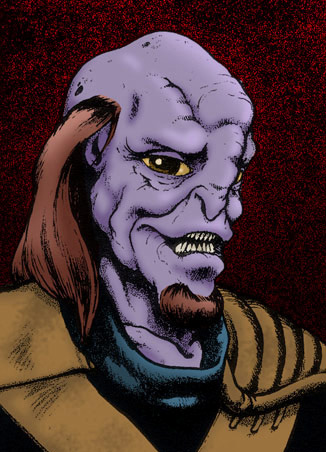
Gamgalon eyed the hunting of exogorths.
Sometime after Clabburn the Elder introduced the slugs to the field, the Krish game hunter Gamgalon responded to an advertisement placed on the HoloNet calling for a healthy space slug, declaring that he had discovered a 900-meter-long specimen in the Hoth asteroid field and that he believed he could deliver it in a couple weeks' time. However, he noted the difficulty in capturing the slug, explaining that he would require a special towing ship and heavy extraction machinery, a substantial amount of sedative to incapacitate the slug, and would potentially demand more than the originally advertised 100,000-credit bounty, depending on the difficulty of securing the creature from its Hoth asteroid field home.
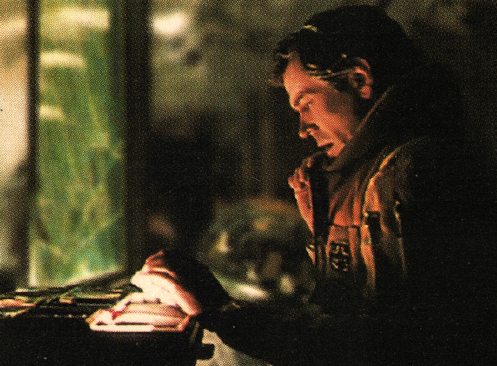
Captain Serper at work at Echo Base
In 2 ABY, the Alliance to Restore the Republic's High Command established the secret Echo Base on the planet Hoth. As observed by the base's leading engineer, Major Kem Monnon—who compiled a report on Hoth and the asteroid field's effects there—the world's remote nature and perpetual bombardment of meteorites proved to be a perfect natural camouflage from the probing eye of the Empire. Nevertheless, the system's constant meteor activity was a hindrance to any attempts to track would-be approaching ships. In response, the Alliance established Echo Stations around the planet Hoth to monitor the Hoth system's meteor activity and detect signs of Imperials; the task fell to Echo Base scanner Captain Wyron Serper to determine what was an asteroid and what could be an Imperial scout ship.
As Echo Base neared completion that year, a group of Rebels were assigned to deliver a supply shipment—including construction equipment, weapons, droids, and other items—to the Rebel facility on Hoth. Upon arriving in the Hoth system, the Rebel couriers found themselves somewhat off course and had to traverse a section of the Hoth asteroid field before landing on the ice planet.
When an Imperial-launched Viper probe droid crashed into the planet Hoth in 3 ABY, the Rebels failed to detect it as a threat. Jedi-aspirant–cum–Rebel Commander Luke Skywalker, unfazed by yet another meteorite impact, reasoned it could have been a man-made instrument. Distracted by the crash, Skywalker was assailed by a native wampa beast and nearly killed. The Rebels investigated the "meteorite" later on, only to realize that it was indeed an Imperial probe droid. The Alliance began evacuating Echo Base, as the droid had informed the Empire of their presence, leading to the Battle of Hoth.
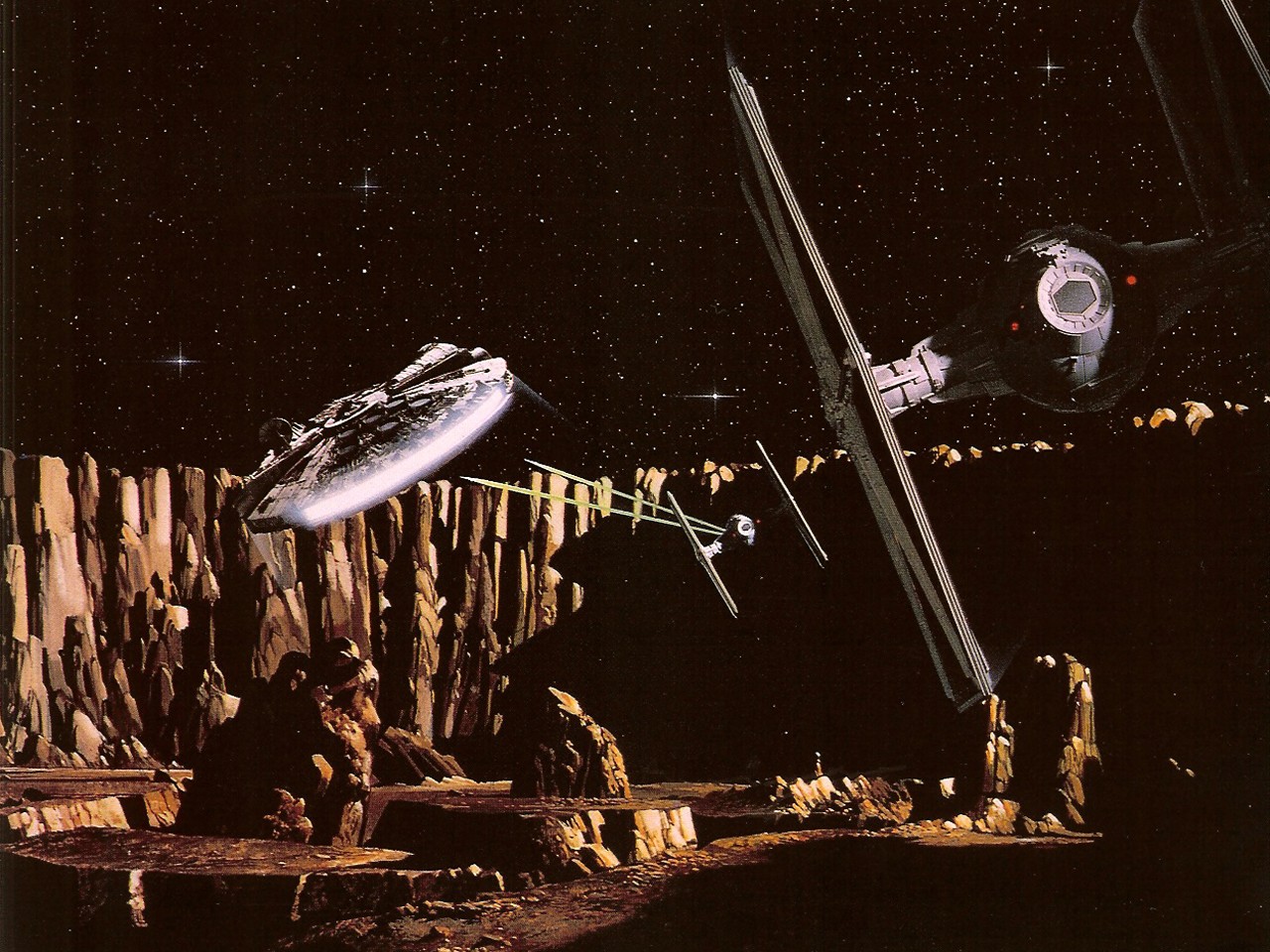
TIE Fighters pursue the Millennium Falcon across one of the larger asteroids.
Instead of maintaining a distance from the Rebel sensors and obscuring itself under the asteroid field's chaos, the Imperial fleet, under Admiral Kendal Ozzel's command, exited hyperspace close to the Hoth system. The Imperial enforcer Darth Vader deemed the move foolish and executed Ozzel, but the Empire still successfully invaded Echo Base. As they did so, many fleeing Rebel ships were able to use the asteroids to their advantage to evade the Imperial blockade of the planet and enter hyperspace. Among the last Rebels fleeing Hoth were Solo and his smuggler partner, Chewbacca, aboard the Millennium Falcon with Princess Leia Organa and the protocol droid C-3PO in tow. They were followed closely by Vader's personal fleet of Star Destroyers, Death Squadron.
Much to the chagrin of Solo and his passengers, the Falcons malfunctioning hyperdrive failed to engage, trapping them in realspace. While Solo feverishly worked on the ship's interior systems in an attempt to effect their escape from the Imperial Starfleet, Organa inadvertently piloted the Falcon into the Hoth system's asteroid field. Stuck—quite literally—between a rock and a hard place, Solo had little alternative but to plunge his ship further into the asteroids. Through masterful flying and near-suicidal maneuvering, he escaped from a flight of TIE/LN starfighters, led by Arnod, whose pilots were unable to avoid crashing into the asteroid maelstrom. Solo eventually piloted his ship into a cavernous opening of one of the biggest asteroids, located in the Anoat system's portion of the field, where he hoped to hide long enough to complete repairs on his hyperdrive.

Dash Rendar's Outrider
Almost simultaneously, the mercenary Dash Rendar, who had also escaped from Hoth after delivering a shipment of supplies to Echo Base, was similarly chased into the asteroid field by an Imperial II-class Star Destroyer and a large contingent of its starfighter complement. Unlike Solo, Rendar's ship, a sleek YT-2400 light freighter named the Outrider, was not in disrepair. Rendar manned his freighter's heavy laser cannons while his copilot droid, LE-BO2D9, flew the vessel into the field after bypassing the Star Destroyer, which remained at the fringe of the belt. Rendar was able to hold off several squadrons of TIE Fighters and TIE/sa bombers long enough until the Outrider was far enough away from the asteroids to safely make the jump into hyperspace.
One of Echo Base's thirty GR-75 medium transports that attempted to escape through the Imperial blockade of the planet, the Treasure Trove, was crippled and lost within the asteroid belt during the battle. The transport managed to dock along the edge of a crater on a large asteroid the size of a capital ship. Rebel General Carlist Rieekan noticed the transport missing when it failed to regroup with the Alliance Fleet at the Rebels' predetermined rendezvous point beyond the Galactic Rim, where it was meant to deliver a valuable shipment of blaster gas. He dispatched a team of special agents aboard the Out Runner, a YL-2200 light freighter, who located the Treasure Trove in the field, only to find its crew dead.
Once the Rebel agents returned to the Out Runner, they were beset upon by the Rodian bounty hunter Chreeto the Defiant and his crew, operating as Imperial retainers. Hoping to capture the Rebels, Chreeto pursued the Out Runner through the asteroid field in his YT-1300 light freighter, the Prowling Wolf. The Rebels, however, successfully escaped the bounty hunters.
At one point, a Rebel pilot captured by the Empire and scheduled for interrogation aboard a naval officer's first command was rescued by the medic Ahleazah, and together they fled via escape pod just as the Imperial ship entered hyperspace near the Anoat system. The main Imperial task force then headed into Anoat's asteroid field, allowing a Rebel search and rescue team to retrieve the escape pod.
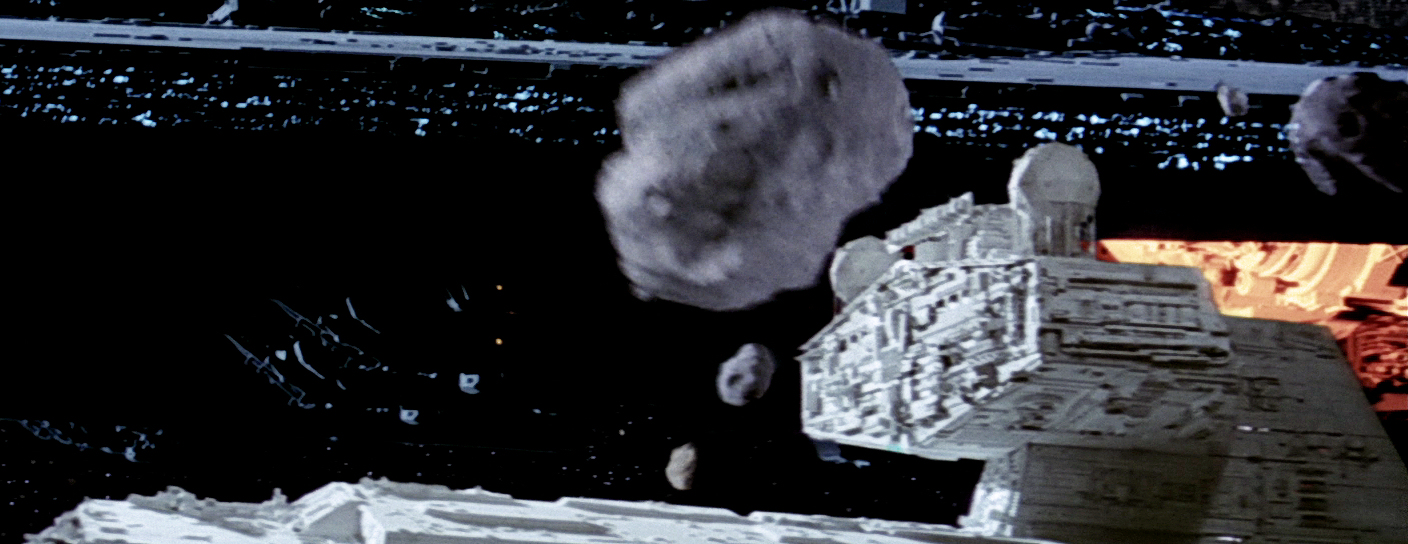
Death Squadron strode into the asteroid field, pursuing the Falcon…
Despite the threat of damaging asteroid collisions, the Imperial II-class Star Destroyer Avenger boldly led Death Squadron's chase of the Millennium Falcon into the field. Once the Millennium Falcon disappeared from sight, however, the Avenger slowed its pursuit near the edge of the belt. Vader nevertheless ordered his fleet of Star Destroyers into the asteroid onslaught. He believed that Luke Skywalker had escaped Hoth aboard the Millennium Falcon with the rest of his companions. All of Vader's Star Destroyers, including his own flagship, the 19-kilometer-long Super Star Destroyer Executor, were diverted into the asteroid field amid a flurry of damaging collisions and incidental casualties suffered aboard several of the Star Destroyers. One Star Destroyer was obliterated by a single asteroid strike at its bridge tower.
Captain Lorth Needa, commander of the Avenger at the forefront of the fleet, reasoned with Vader that the Millennium Falcon must have been destroyed, but Vader knew better. He ordered the Executors Admiral Firmus Piett to dedicate every ship of Death Squadron to the search effort. The Avenger continued to charge forward, clearing a path through the asteroids for the remainder of the fleet to follow, while flights of TIE bombers littered the biggest asteroids with explosives, hoping to chase out their quarry. At Vader's request, the Executor alone exited the asteroid field for a while to facilitate a clear hologram transmission between him and Emperor Palpatine—he instructed Vader to capture or destroy Luke Skywalker lest the Rebel was to become a Jedi.

…though the Star Destroyers fell victim to tumbling asteroids.
The Millennium Falcon spent several days hiding within the massive asteroid while Solo and his passengers worked to repair the ship's faulty hyperdrive. Solo shut down the ship's primary systems in order to avoid detection by the probing Imperial ships the group could hear overhead trying to chase them out. It was while cooped up within the close confines of the Millennium Falcon that the longstanding romantic tensions between Solo and Organa began to blossom. The princess finally warmed to Solo's roguish charms as they shared one of their first kisses within the deep innards of the asteroid.
However, it was not the might of the Imperial Starfleet that eventually flushed the Millennium Falcon out of its hiding place. The group soon discovered that mynocks living inside of the cavern had attached themselves to the ship's power cables, leeching the ship of its energy. While clearing the ship of the parasites, Solo and Chewbacca unwittingly discovered the true nature of their hiding spot. Stray blaster bolts fired into the walls of the cave had caused the grotto to shake violently. It was not a simple cave that Solo had hidden his ship in, but the nesting area of a giant exogorth.
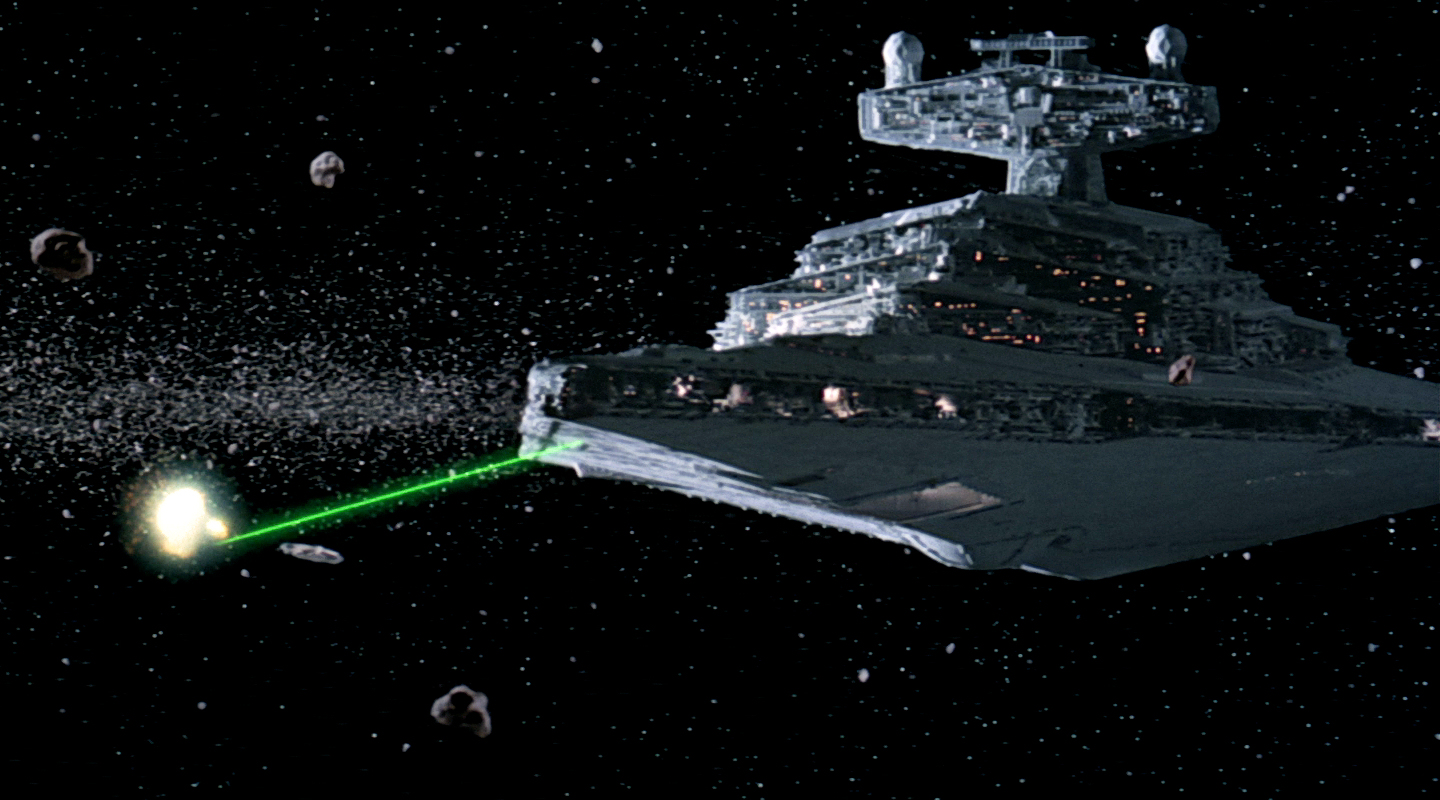
The Star Destroyer Avenger chases the Millennium Falcon out of the asteroid field.
Solo was able to pilot his ship out of the closing jaws of the massive space slug with only seconds to spare. As the Rebels expected, they were once again engaged by the Imperial fleet upon reentering the asteroids: Two TIE scout ships detected the Millennium Falcon and broke orbit, returning to the main Imperial fleet. Alerted, the Avenger soon continued chasing the Falcon. Fortunately for the Rebels, they exited the confines of the asteroid field after traversing its expanse. Free of obstruction, Solo once again tried to engage his hyperdrive with repairs believed completed, only to find, much to the dismay of everyone aboard, it was still inoperable.
The Avenger was the only ship attached to Death Squadron that managed to stay with the Falcon through the entirety of the asteroid field, earning the warship a reputation for persistence among the Imperial Starfleet. Needa had sent his Star Destroyer headfirst into the asteroids as Vader had commanded, sustaining substantial damage in the process. It was all his gunnery crews could do to try and keep up with the endless task of trying to shoot down the rocky debris in the Star Destroyer's path. So, when Solo suddenly and unexpectedly banked the Millennium Falcon on an attack course straight for the pursuing Avenger, Needa and his crew were ill-prepared and lost the Rebel ship for good. Vader subsequently executed Needa for his failure.
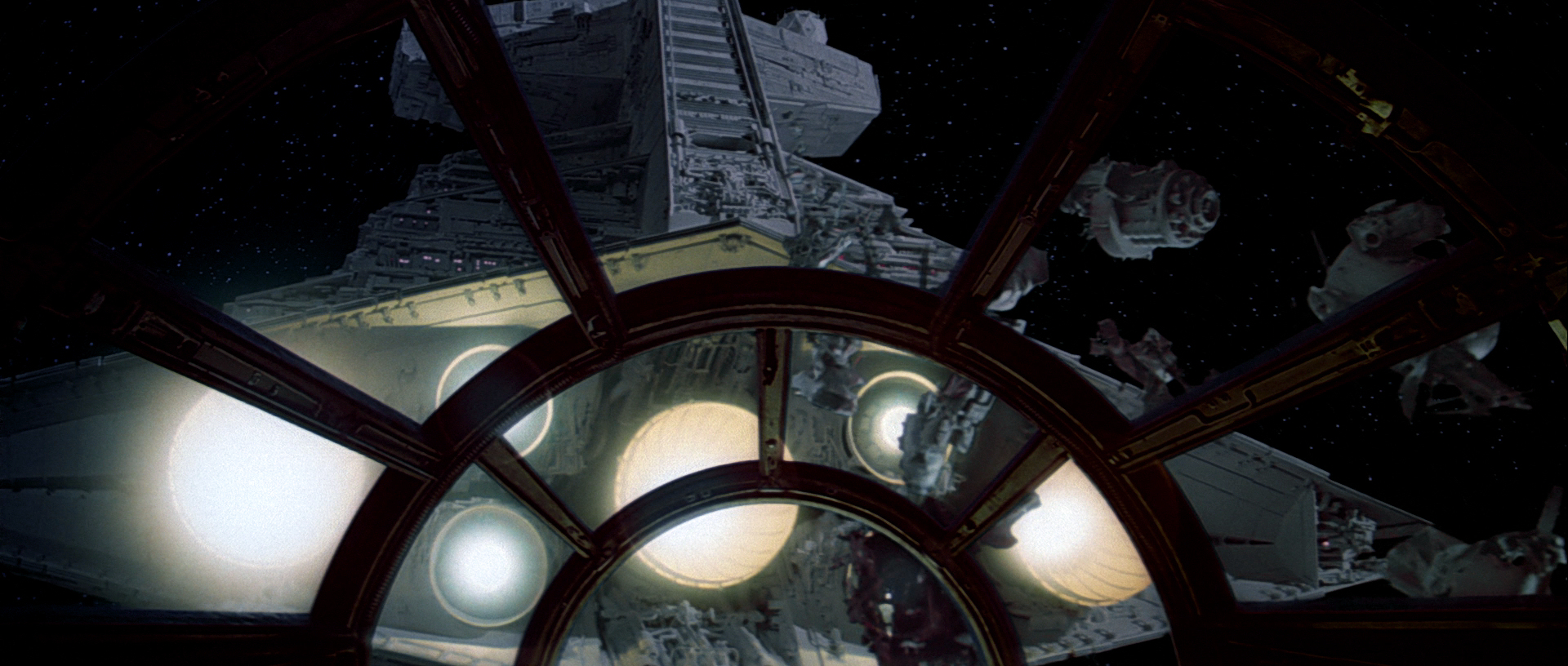
A view from the Millennium Falcon's cockpit as it drifts away with the ejected junk of the Avenger
Solo had attached the Millennium Falcon to the backside of the Avengers bridge command tower, where the Imperial Starfleet neglected to look. Solo knew that, per standard Imperial procedure, large warships such as the Avenger customarily jettisoned their garbage allotment before entering hyperspace. When the Imperial fleet, having conducted a scan of the area in the Anoat system, finally decided that their prey had indeed escaped into hyperspace and began exiting the area themselves, Solo simply allowed his ship to tumble away undetected with the rest of the Avengers refuse.
Even before the Battle of Hoth began, the Empire had announced a reward for any bounty hunters who helped chase the Rebels fleeing from the system. Once it became clear to Vader that the ineptitude of his own fleet would likely never bring him those he sought, he sent out his own call for an elite group of hunters to capture the crew of the Millennium Falcon hiding within the asteroid field. Six bounty hunters, highlighted by the notorious Boba Fett, were instructed to rendezvous with Vader's Executor just outside the field, where they were briefed on the details of their mission.
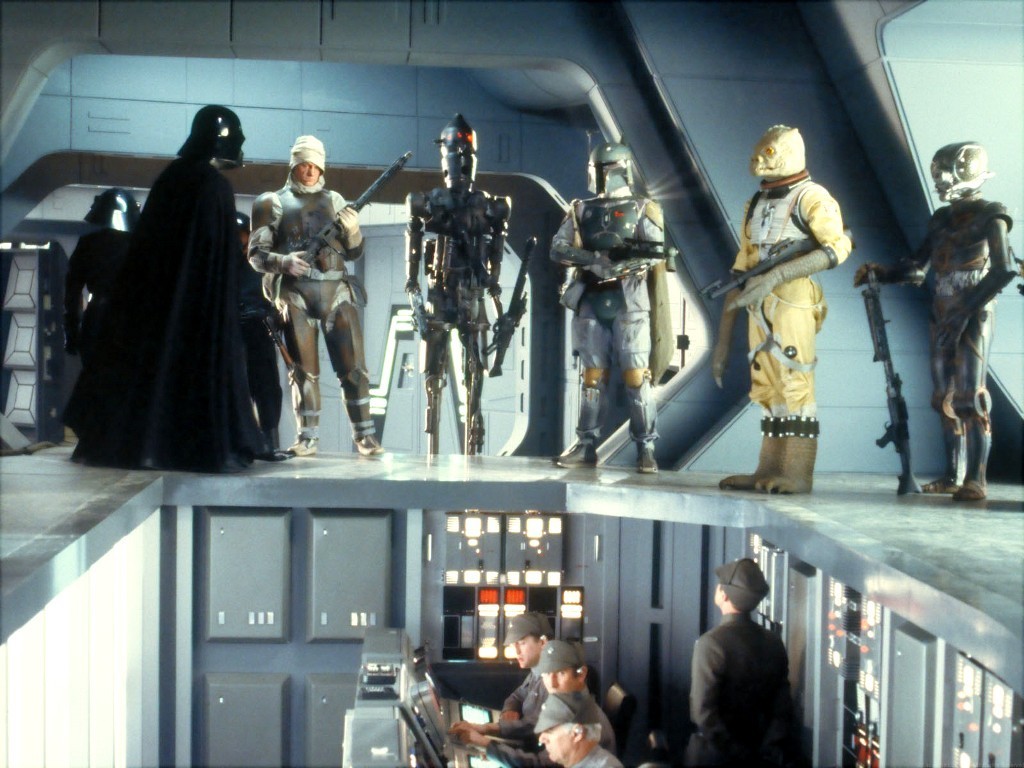
Bounty hunters aboard the Executor.
Just as Vader's briefing was finished, the Avengers failure to capture the Millennium Falcon was reported throughout the fleet. The hunter Dengar surmised correctly—albeit too late—that Solo had hidden his ship within the asteroids, taking advantage of the fact that the high metal concentration of the field would distort sensor readings and help mask his location.
His own hours-long search within the field came to an abrupt end when one of his own strategically-placed sensor beacons, powerful enough to counteract the metal-induced distortions, detected a badly damaged Millennium Falcon limping away from the system at sublight speed. Before Dengar could close in on his prey, however, a taunting transmission from the rival Fett activated a preemptively planted bomb within Dengar's ship, destroying the engines and neutralizing the craft. Dengar could only watch helplessly from the asteroids as Fett tracked Solo's departure away from the field.
The existence of an enormous space slug within the asteroid field had been written off as spacer legend until Solo's run-in with the creature, which the captain reported after rejoining the Alliance Fleet. Rebel historian Voren Na'al learned of the Millennium Falcons asteroid field ventures from Solo, and noted in his journal details about the field and the incredible discovery of the giant space slug. Na'al further recorded that the findings shed light on the legends of Clabburn's space slugs in the asteroid belt.
Still, some continued to disbelieve the story given Solo's reputation for exaggeration. Reports of exogorth encounters such as Solo's alerted biologists to their existence and offered a mystery as to how such enormous beasts came to thrive among the asteroids. To their shock, they eventually discovered that the exogorths engorged on asteroid rock, with the dual purpose of nutrition and burrowing.
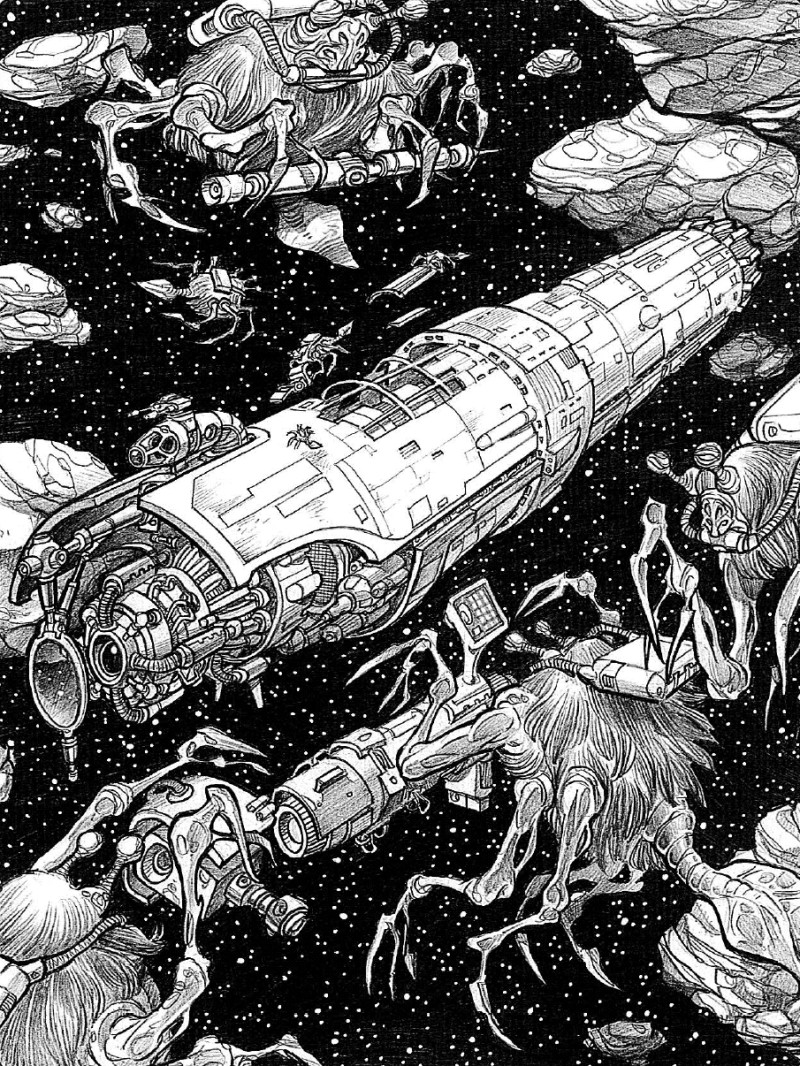
The Darksaber under construction
By 12 ABY, when the galaxy was largely governed by the Rebel Alliance's successor, the New Republic, the Hutt criminal empire had created the Orko SkyMine Asteroid Processing Corporation under the direction of the Hutt overlord Durga Besadii Tai in what the corporation described as "the largest mining venture ever undertaken in the asteroid belt." In reality, the corporation was nothing but a sham commercial enterprise designed to mask the copious amounts of funds being diverted into the Hutts' true goal: the construction of a superweapon powerful enough to rule the entire galaxy. Nicknamed the Darksaber Project by its chief engineer, Bevel Lemelisk, the weapon would be constructed within the heart of the asteroid field itself, created from the asteroids' metal ore. The remote location of the Hoth system and the field's limitless resources made the Hoth asteroid belt the perfect construction site.
Early construction phases consisted of extracting the precious metal from the asteroids using two massive Automated Mineral Exploiters, named Alpha and Beta, respectively. The processing units were little more than cargo containers equipped with turbolasers to reduce an asteroid to small debris before a forward mouth would swallow the rubble, spit out the useless slag, and retain the valuable ore. Each exploiter was designed to lock onto the heaviest concentration of metal in its general vicinity and commence with processing. The two machines each met their demise when they unexpectedly detected each other as sources of incredibly pure metal and ground one another down to scrap—a disappointing but ultimately minor setback for the Hutt operation.
A file on the Hoth asteroid belt's resources had been made by Orko SkyMine to prepare for the project, and the author, having witnessed the mining disaster from a former pirate base in the field along with their Orko SkyMine team, wrote an incident report on the failure of the Mineral Exploiters. Their identity was subsequently purged—and the being potentially destroyed—by a displeased Durga the Hutt. Fearful of Durga's retribution for his faulty designs, Lemelisk declared the two Mineral Exploiters prototypes and promised to correct the programming error in the second batch: Exploiters Delta and Gamma.
The new mineral smelters, altered to ignore one another as a potential metal resource, proceeded with greater efficiency than their predecessors. Before long, the Darksaber weapon itself began to take shape among the asteroids: a long cylindrical shaft housing a planet-destroying superlaser derived from the original plans to the first Death Star battlestation. Seeing that his creation would resemble a lightsaber hilt with extended blade when fired, Lemelisk derisively coined the project Darksaber, much to the amusement of Durga.
The Hutt had tasked the project's labor to multitudes of multi-armed, mind-linked creatures known as the Taurill, who were fitted with vacuum suits enabling them to manually build the weapon from the gravitation-void of space. Construction was delayed several times due to the easily distracted nature of the Taurill. Governed by an Overmind, in which each member of the hive was linked mentally, the attention of the Taurill was occasionally diverted by a nearby passing asteroid or a smuggling ship that had entered the area. When the Taurill returned to their labor, they would continue construction on a different portion of the Darksaber superstructure, destroying previously created cohesiveness.
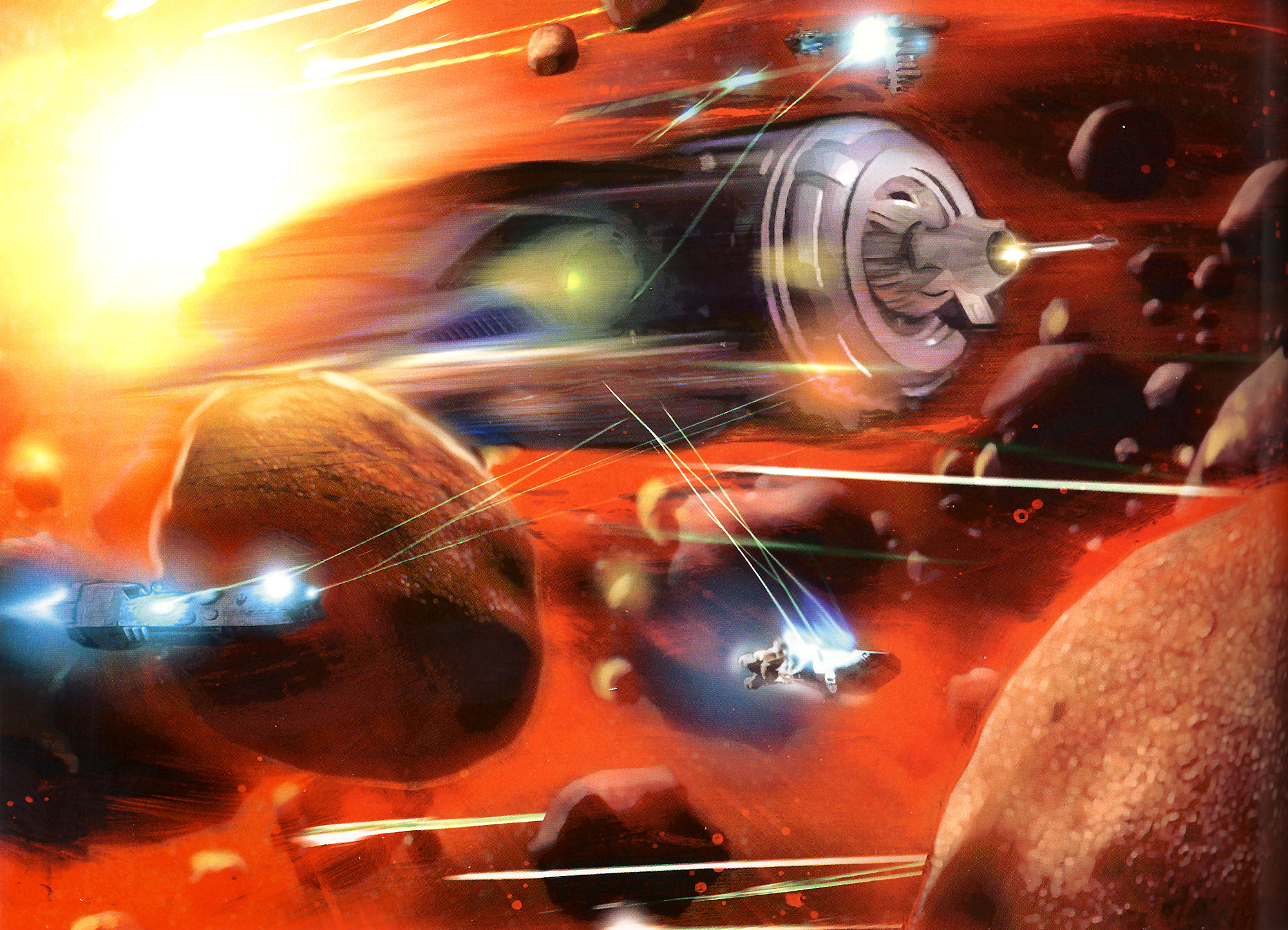
The Darksaber superweapon, under attack by New Republic forces in the asteroid field
Following the Jedi Luke Skywalker's unsuccessful journey to the planet Hoth to help the Jedi Knight Callista Ming regain control of the Force, Skywalker and Ming entered the asteroid field in a barely functioning space yacht, damaged on the ice planet by wampas. With life support systems failing on the ship, Skywalker telepathically communicated with Leia Organa Solo, his sister, across the vastness of space to call for help. Guided by the siblings' connection through the Force, she and Han Solo tracked down the damaged yacht and rescued the two stranded Jedi. However, they were unaware that the Hutt superweapon that the New Republic had recently become privy to was being constructed in the very same asteroid field.
The Darksaber project was discovered almost immediately thereafter by a search-and-destroy mission led by New Republic General Crix Madine. Madine and two other commandos entered the field in RZ-1 A-wing interceptors, although one of the pilots, Korenn, was killed by a colliding asteroid, and infiltrated the construction site in self-propelled vac-suits. Despite the capture and death of both Madine and his fellow agent, Trandia, a distress signal transmitted by Madine through the HoloNet directly to the New Republic Defense Fleet prompted a response by a task force led by General Wedge Antilles.
Antilles' fleet surged through the field, suffering considerable damage as they approached the Darksaber, which had fled into the most chaotic part of the belt on Durga's orders. Pummeled by a salvo of laser fire from the pursuing New Republic warships, the Hutt superweapon was ultimately obliterated between two massively sandwiching asteroids, killing Durga and creating yet more scattered debris among the field.
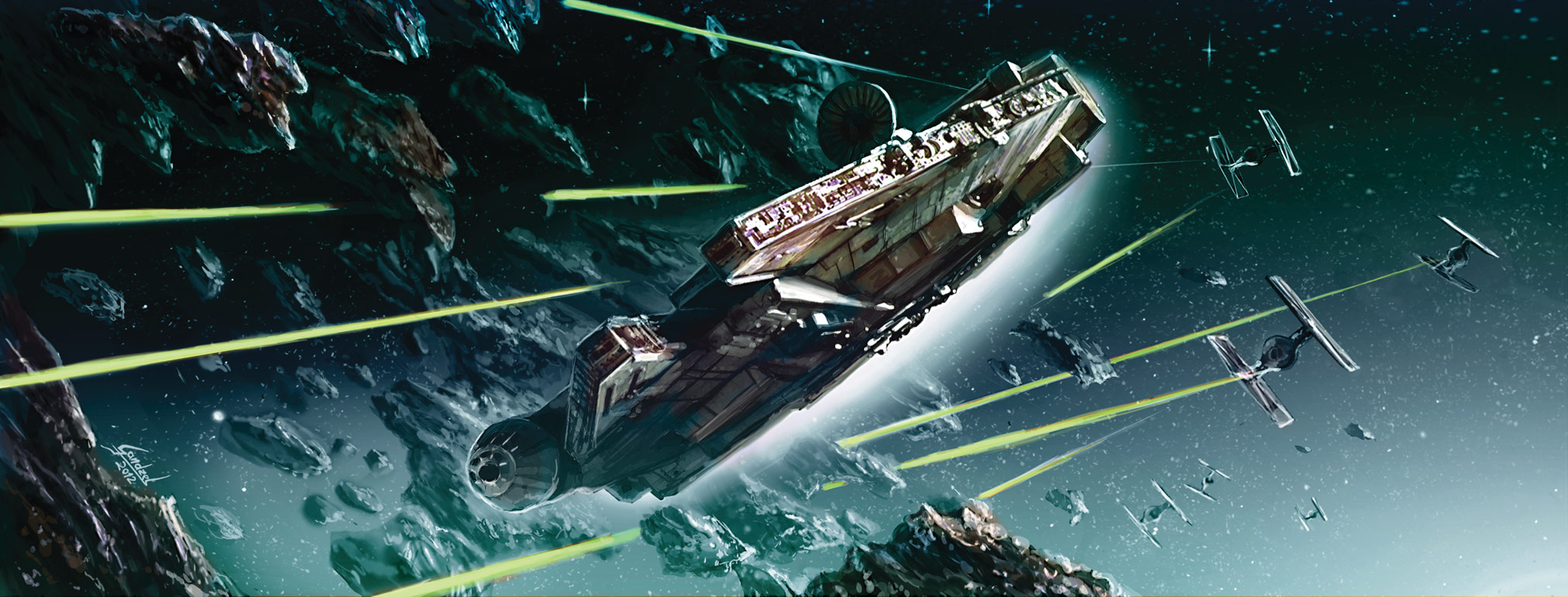
The Millennium Falcon maneuvering the myriad asteroids of the field.
In addition to various pirate bases, the Hoth asteroid field contained mining shafts and stations. Clabburn the Elder's strongholds were built in the larger asteroids, and similarly, Airtight Base, the pirate stronghold of Clabburn the Younger, was built inside a large asteroid. Among the most massive asteroids in the field was the Big One, which was home to an exogorth wherein the Millennium Falcon briefly hid during its escape from the Imperial fleet.
The legend of the asteroid Kerane's Folly told of it consisting almost entirely of platinum, but prospectors had repeatedly failed to rediscover the famed rock. Yet another member of the field was the Poison Moon, named for its surface appearance, where the Jedi constrained a rogue member of their Order. The Darksaber superweapon was constructed in the asteroid field and, as with many vessels that have ventured into it, was destroyed therein.
The Hoth asteroid field first appeared simultaneously in Donald F. Glut's novelization and Shep Steneman's The Empire Strikes Back Storybook adaptation of the original trilogy film Star Wars: Episode V The Empire Strikes Back; both were published on April 12, 1980, just prior to the Irvin Kershner film's May theatrical release. West End Games sources provided two alternative names for the Hoth asteroid field: 1993's The Movie Trilogy Sourcebook, refers to it as the "Anoat Asteroid Belt," while the roleplaying game adventure "The Treasure of Celis Mott," published in 1996 for Star Wars: The Roleplaying Games Instant Adventures book, names it the "Hoth Belt." Wizards of the Coast's 2001 Star Wars Roleplaying Game supplement Rebellion Era Sourcebook later gives the full name "Hoth Asteroid Belt."

Ralph McQuarrie's concept art for the space slug
The idea of entering an asteroid field to escape the enemy first appeared in Star Wars creator George Lucas' rough draft of the original 1977 Star Wars film, in which General Skywalker enters the Norton Asteroid Belt to elude Imperial forces. While the chase through the asteroid belt is included in every version of The Empire Strikes Back screenplay, some versions place the sequence after the Millennium Falcon reaches the Rebels' rendezvous point, where the ship is met by a massive Imperial fleet. In The Empire Strikes Backs original script, Hoth and its system's asteroid belt are located in a region of space known as the Granita Clusta. The second draft of the script introduces the mynock attack on the Rebels inside the large asteroid. Coupled with Darth Vader emerging from his meditation chamber and taking orders from the hitherto unseen Emperor at the same point in the film, the revelation that the "asteroid cave"—in which the Rebels were taking shelter and where Han Solo and Leia Organa opened themselves to love—was a space slug is drawn from the mythological motif of the journey into the belly of the beast, symbolizing consumption and rebirth.
The concert piece "The Asteroid Field," which was composed by John Williams as part of the London Symphony Orchestra–performed score to The Empire Strikes Back, is dedicated to the chase of the Millennium Falcon through the Hoth asteroid field. The brief moment of calm within the asteroid field benefitted from a sense of mystery, which was created by the use of string instruments, a celeste, a harp, and synthesizer in Williams' score during the mynock scene.

Hoth asteroid field concept art, by Ralph McQuarrie
Based on conceptual art by Ralph McQuarrie and storyboards by Joe Johnston, Nilo Rodis-Jamero, and Dave Carson, designers at Industrial Light & Magic (ILM)—newly headquartered at the Kerner Building in San Rafael, United States—used between twenty-five to twenty-six different visual elements in one scene to create the chase through the Hoth asteroid field. With some shots in the film containing thirty-eight elements, the asteroid field pursuit was its most complex bluescreen sequence, encompassing shots of the Millennium Falcons cockpit interior, shots of various Falcon models, and shots of separate Star Destroyer models, TIE fighter models, and asteroid models, in addition to matte paintings and sets for asteroid surfaces and starfields.
On December 8, 1978, visual effects photography director Dennis Muren decided, with others' input, that asteroid explosions would be shot live on film before being re-photographed in rotoscope, where the mattes could be composited for complex actions. Photography at ILM began in February 1979, with work being done on the asteroid sequence, among others, although the crew were limited to the use of only two cameras—the John Dykstra–developed Dykstraflex and another motion control Technirama—until August. Before principle photography commenced under Director of Photography Peter Suschitzky in England's Elstree Studios later in spring, Muren, to ensure consistency in lighting, asked him to shine the key lights from the left when the Rebels approach the asteroids.

The "asteroid box"
Among the visual elements were hundreds of asteroids, including those in an "asteroid box," "asteroid big box," or "asteroid mover," that had various layers and was composed of thirty to forty small clay rocks suspended from black rotating monofilament strings, which were connected from above by a chain operated by a crank, to represent an extensive asteroid cluster. The motorized machine, which had hundreds of gears and rotated asteroids at varying speeds with repeatable moves, was engineered by Supervising Stage Technician Ted Moehnke.
Asteroids closer to the viewer were represented by pieces of polystyrene coated in plaster, attached to pronged pipes, and painted at the ILM model shop by artists such as Steve Gawley. Gawley and other modellists initially had to spend some time on determining the best way to create the look of the asteroids. Visual effects cameraman Ken Ralston, due to the tediousness in making the models and him thinking that they looked like potatoes, at one point purchased with his assistant, Selwyn Eddy, some actual potatoes in place of the polystyrene asteroids. The potatoes were smoother than the asteroid pieces and flew by the Millennium Falcons cockpit in the final cut. A tennis shoe was also included among the asteroids.

Lorne Peterson with his space slug jaw model
For the large asteroid the Rebels fly into, both a combination model of at least the crater and the surrounding surface as well as matte paintings were used against a black backing. The crater set, measuring around thirty feet in diameter, was built by Joe Johnston, Michael Pangrazio, and Chris Anderson out of dense foam and topped with white dust on May 4, with Pangrazio also having done the matte paintings of larger asteroids and starfields using oil paints. The model shop's rubber hand puppet for the space slug would be added to the crater set, and on September 4 ILM decided to wait until the slug is completed before determining the look of the asteroid/space slug tunnel that the Falcon would fly though. For a closer shot of the space slug's jaws, a large model was made by the model shop's supervisor, Lorne Peterson.
On May 11, associate producer Jim Bloom split shooting at ILM three-ways between Muren, Ken Ralston on nightshift, and effects cameraman Jim Veilleux filming asteroid belt and starfield paintings. The film's final cut includes one of the gag footages shot by Ralston, where the camera skims over an asteroid surface. The latter part of the footage was cut: the camera goes on to approach a mock–space slug puppet, made from an old sock, that exits a crater and attacks one of the two TIE fighters flying overhead.
All of these elements were shot separately against a bluescreen using motion-control photography before being composited with "the Quad"—an optical printer that ILM, whose optical photography department for Empire was headed by Bruce Nicholson, built themselves. The approach was pioneered by visual effects co-supervisor Richard Edlund, complete with unprecedented computer-controlled capabilities and other technological workarounds. The machine was not operational until late October 1979. Some shots of the Falcon and TIEs in the asteroid field had to go through the Quad four times to ensure the color timing was correct and the matte lines were eliminated.
Filming of the elements that would be fed into the optical printer had taken place over many months, with asteroid sequence tests taking place from late March, 1979, and the first test asteroid shot being composited on April 6. It was deemed to be discombobulated and distracting from dramatic impact and had to be simplified. The asteroids initially coming every which way produced a disorientating effect; in order to create a sense of direction and threat from the asteroids, Johnston and Muren had redesigned the asteroid sequence's shots so that the rocks came largely from one direction. Ralston additionally programmed the movement of the ships and asteroids in the asteroid field sequences to create a vivid and kinetic sense of dynamism, and animatics of the chase created by ILM's animation department allowed editors to more easily coordinate the timing and pacing of the scene. Shots of the Falcon weaving through asteroids laterally were filmed in early June, and most of the effects shots for the asteroid sequence were in place by the time of the first cut's completion by October 17.
Lucas' Eisensteinian film editing philosophies in The Empire Strikes Back came into play as he had to consider the screen directions of objects flying past the camera while cutting the film over and over again. On October 31, Joe Johnston and his assistants used Lucas' cutting copy to sketch the frame composition and continuity of effect sequences. From those sketches came storyboards, which informed camera crew and model builders the angles and moves their miniatures had to make. On November 7, George Lucas and ILM screened clips of the sequence to discuss further adjustments. Notably, the editing and shot composition of the asteroid sequence contains some esoteric moments, such as the Falcon leaving the frame prior to entering the big asteroid.
When filming on Elstree Studios' Stage 5 in March 1979, Darth Vader actor David Prowse would alter his lines for a laugh, with "The asteroids do not concern me, I want that ship" being spoken as "Hemorrhoids do not concern me, I need a shit." Producer Gary Kurtz observed that the Millennium Falcons cockpit set, with blue screens placed around it on Stage 8 of Elstree Studios in the summer, was the most challenging, especially for the actors. Carrie Fisher, the actress playing Princess Leia Organa, found the blue screens hard to work with as she would have to scream at imaginery asteroids; Harrison Ford once took up a saw in anger and sawed through the set. Even Peter Suschitzky required some help with lighting the set, and Irvin Kershner had some difficultly handling the special effects, blue screen, and matte painting scenes.
For the "asteroid cave"—more accurately the space slug interior—filming took place on June 18 on Elstree's Stage 6, which featured the Millennium Falcon exterior and was laid with black Visqueen plastic sheets and dry ice clouding the stage floor, surrounded by draping black curtains.
Several Star Wars sources depict C-3PO as providing Han Solo with different odds for navigating an asteroid field: the novelization of The Empire Strikes Back and the film's Marvel Star Wars comic adaptation, Star Wars (1977) 41 include odds of 2,467 to 1; the plot synopsis of The Empire Strikes Back - Official Collectors Edition magazine places the odds at 365,000 to one; the radio adaptation of The Empire Strikes Back lists odds of 725 to 1; while the radio drama's script, originally published in The Empire Strikes Back: The National Public Radio Dramatization, puts the odds at 720 to 1.
Dave Wolverton's short story "Payback: The Tale of Dengar," which was published in 1996's Tales of the Bounty Hunters anthology and details Dengar's search of Han Solo and the Millennium Falcon through the asteroid field, describes nearly a half-hour passing between the time the Imperial fleet enters hyperspace and the Millennium Falcon, having hidden itself in the Star Destroyer Avengers jettisoned garbage dump, begins to limp out of the system, while Dengar is ultimately left incapacitated within the asteroid field. This time is seemingly inconsistent with the film The Empire Strikes Back, which depicts the Millennium Falcon as beginning its departure from the region immediately after the departure of the Imperial fleet.
Kevin J. Anderson's 1995 reference title The Illustrated Star Wars Universe specifies that the Hoth asteroid field was formed from a collision "billions of years" before the Galactic Civil War, whereas Wizards of the Coast's 2001 roleplaying guide Rebellion Era Sourcebook mentions that it occurred "millions of years" ago instead. This article treats the original information of billions of years as correct.
The video games LEGO Star Wars II: The Original Trilogy (2006) and LEGO Star Wars: The Complete Saga (2007), which are non-canonical to the Star Wars Legends continuity, recreate the Millennium Falcons flight through the asteroid field, adding unique game mechanics not seen in the film. Nintendo GameCube's Star Wars: Rogue Squadron II: Rogue Leader, released in 2001, offers the Hoth asteroid field as a bonus level that closely resembles the film's storyline, in which the player must also recreate the Falcons chase through the field before completing the level by attaching the ship to the backside of a Star Destroyer's bridge tower. In 2003's Star Wars: Flight of the Falcon for Game Boy Advance, the player enters hyperspace at the conclusion of the game's asteroid field level, a clear contradiction of established canon in Star Wars Legends.
The asteroid field and protagonists featured in The Empire Strikes Back has inspired the naming of two cameras—LUKE (LICIACube Unit Key Explorer) and LEIA (LICIACube Explorer Imaging for Asteroid)—installed on the LICIACube satellite, part of NASA's Double Asteroid Redirection Test mission in 2022 to test ways of preventing asteroid impacts on Earth.
- Star Wars: Flight of the Falcon
- LEGO Star Wars II: The Original Trilogy
- LEGO Star Wars: The Complete Saga
- Star Wars Pinball
- William Shakespeare's The Empire Striketh Back: Star Wars Part the Fifth